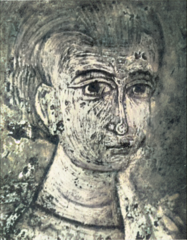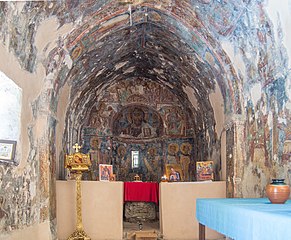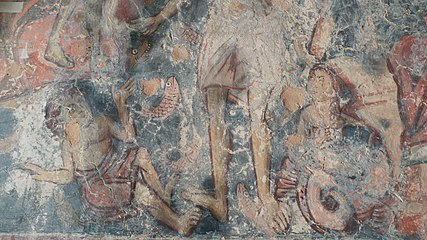Ioannis Pagomenos
Ioannis Pagomenos | |
|---|---|
 Virgin Mary by Ioannis Pagomenos | |
| Born | c.1285 Candia, Crete (?) |
| Died | after 1340 Crete (?) |
| Nationality | Greek |
| Style | Byzantine |
Ioannis Pagomenos (Greek: Ιωάννης Παγωμένος, c.1285[1]–after 1340) was a Greek painter in the Byzantine style active in Venetian-ruled Crete. He created fresco cycles for rural Orthodox churches under commission from ordinary members of the local peasant communities, who acted as collective patrons. While he could be considered a forerunner to the Cretan School, which saw success in producing hybrid-style icons for an international clientele, his work was more traditional in character and only incorporated Western influences in secondary details, as it catered to regional tastes.[2][3] His style nonetheless shows significant development over the years.[4] His frescos survive in four districts of the Chania prefecture, with the majority in the mountainous province of Selino, which displays the highest density of church painting in Crete.[5] His art influenced Andreas Pavias, Angelos Akotantos, Andreas Ritzos, and Nikolaos Tzafouris.[citation needed] By 1337/8 Pagomenos was working together with his son Nikolaos within the framework of a small family workshop of painters, other examples of which are known from contemporary Crete and the Aegean.[6][7][8]
Life
[edit]Pagomenos was most likely born in Candia where his surname is well attested, in contrast to Selino. He is also supposed to have trained there as an artist, due to the weakness of Chania as an urban centre at the time.[9] The early fourteenth-century Cretan painters Theodoros Daniil and his nephew Michail Veneris, also active in western Crete, might have exerted a formative influence on Pagomenos before he developed his own distinctive style.[10][11][12] His contemporaries elsewhere in the Byzantine Empire included Manuel Panselinos, Michael Astrapas and Eutychios from Macedonia. The only record of Pagomenos' life is in the churches he signed. His career in western Crete spanned nearly three decades from 1313/4 to 1340, and his workshop continued to operate into the 1360s under the new stylistic direction of his son Nikolaos.[13][14]
Known work
[edit]The painter's own name has been deciphered in nine dedicatory inscriptions to date, with a tenth mention being traced to Pagomenos through family context:[14][15][16]
- St George (Agios Georgios) in Komitades, Sfakia 1313/4 (signed by Pagomenos)
- St Nicholas (Agios Nikolaos) at Moni, Selino 1315 (signed by Pagomenos)
- Dormition (Koimesis) of the Theotokos in Alikampos, Apokoronas 1315/6 (signed by Pagomenos)
- St Demetrius (Agios Dimitrios) at Vrysali in Leivada, Selino 1315/6 (signed by the monk Nifon and by Pagomenos as a second painter)[17]
- St George (Agios Georgios) in Anydroi, Selino 1323 (signed by Pagomenos)
- St Nicholas (Agios Nikolaos) in Maza, Apokoronas 1325/6 (signed by Pagomenos)
- Virgin Mary (Panagia Evangelistria) at Beilitika in Kakodiki, Selino 1332 (signed by Pagomenos)
- Archangel Michael (Archangelos Michail) in Kouneni (now Vathi), Kissamos 1336/7 (signed by Pagomenos and his son Nikolaos)[6]
- St George (Agios Georgios) at Tsarkos/Kakos Potamos in Prodromi, Selino 1337/8 (signed by Ioannis Pagomenos and Nikolaos)[18]
- St John the Theologian (Agios Ioannis o Theologos) in Kalamos, Selino 1340 (signed by a Ioannis and a Nikolaos, i.e. the Pagomenoi)[19][20][21]
In addition, the workshop of Pagomenos has been credited with the below dateable church paintings:
- Archangel Michael (Archangelos Michail) at Kavalariana in Kandanos, Selino 1327/8 (signed by a Ioannis; attribution rejected on stylistic and palaeographic grounds by Lymberopoulou but upheld by Tsamakda also on stylistic grounds)[21][22]
- St John the Theologian (Agios Ioannis o Theologos) at Trachiniakos in Kandanos, Selino 1329 (unsigned, attributed on stylistic grounds to the workshop of Pagomenos)[23]
- Apostles Peter and Paul (Agioi Apostoloi Petros kai Pavlos) in Kopetoi, Selino 1334/5 (attributed by Maderakis)[24][25]
- Virgin Mary (Panagia) in Kadros, Selino 1338/9[26][25]
- St Pantaleon (Agios Panteleimon) in Prodromi, Selino (attributed)[citation needed]
- Virgin Mary (Panagia) at Skafidia in Prodromi, Selino 1347 (signed by a Ioakeim, whom Kalokyris supposes to be Pagomenos under a monastic name, and whom Ioannidou sees as a younger painter in the workshop of Pagomenos, possibly another of his sons)[27][21][28][29]
- St Anna (Agia Anna) at Anisaraki in Kandanos, Selino 1352 (signed by a Nikolaos and another painter)[30][20]
- St Paraskevi (Agia Paraskevi) at Trachiniakos in Kandanos, Selino 1362 (?)[25][31]
Gallery
[edit]- Crucifixion of Jesus
- St Demetrius
- Signature inscription (St Nicholas, Maza)
- St Stephen
- St George (St George, Anydroi)
- St John
- Baptism of Christ (detail) (St Nicholas, Maza)
- Presentation of Christ at the Temple (St Nicholas, Maza)
- Hospitality of Abraham (detail) (St Nicholas, Maza)
See also
[edit]Notes
[edit]- ^ Kalokyris 1958, p. 350.
- ^ Lymberopoulou 2010, p. 170-172.
- ^ "Preserving the Legacy of the Artist Ioannis Pagomenos". Washington University in St. Louis. Retrieved June 18, 2021.
- ^ Tsamakda 2012, p. 105-111, 118.
- ^ Lymberopoulou 2010, p. 161-164.
- ^ a b Ioannidou 2018, p. 337.
- ^ Lymberopoulou 2010, p. 168-170.
- ^ Kalopissi-Verti 2003, p. 62.
- ^ Lymberopoulou 2010, p. 165-166.
- ^ Schmidt 2020, p. 115-116.
- ^ Tsamakda 2012, p. 112.
- ^ Ioannidou 2016, p. 226-228.
- ^ Tsamakda 2012, p. 35, 130.
- ^ a b Ioannidou 2018, p. 343-344.
- ^ Lymberopoulou 2010, p. 164-165.
- ^ Kalokyris 1958, p. 351.
- ^ Ioannidou 2018, p. 330-333.
- ^ Ioannidou 2018, p. 338-339.
- ^ Ioannidou 2018, p. 339-341.
- ^ a b Tsamakda 2012, p. 126.
- ^ a b c Lymberopoulou 2010, p. 165 n. 31.
- ^ Tsamakda 2012, p. 129.
- ^ Ioannidou 2018, p. 333-337.
- ^ Tsamakda 2012, p. 121.
- ^ a b c Ioannidou 2018, p. 343.
- ^ Tsamakda 2012, p. 125.
- ^ Kalokyris 1958, p. 349-350 n. 11.
- ^ Tsamakda 2012, p. 118-119.
- ^ Ioannidou 2018, p. 342.
- ^ Ioannidou 2018, p. 343 n. 48.
- ^ Tsamakda 2012, p. 119, 124.
References
[edit]- Ioannidou, Theodora A. (2016). Το παρεκκλήσι του Αγίου Ιωάννου του Θεολόγου «στων Τραχινιάκω(ν)» Καντάνου της Επαρχίας Σελίνου Νομού Χανίων. Συμβολή στο έργο του Κρητικού ζωγράφου Ιω(άννη) Παγωμένου (α΄ μισό 14ου αιώνα) (PDF) (Master's thesis). Aristotle University of Thessaloniki.
- Ioannidou, Theodora A. (2018). "Διορθώσεις και νέες αναγνώσεις κτητορικών επιγραφών σε ναούς του εργαστηρίου του κρητικού ζωγράφου Ιωάννου Παγωμένου (πρώτο μισό του 14ου αιώνα)". Δελτίον της Χριστιανικής Αρχαιολογικής Εταιρείας. 39: 329–346. doi:10.12681/dchae.18566. S2CID 240163553.
- Kalokyris, Konstantinos D. (1958). "Ιωάννης Παγωμένος, ο βυζαντινός ζωγράφος του ΙΔ΄ αιώνος" (PDF). Κρητικά Χρονικά. 12: 347–367.
- Kalopissi-Verti, Sofia (2003). "Painters' Information on Themselves in Late Byzantine Church Inscriptions". In Bacci, Michele (ed.). L'artista a Bisanzio e nel mondo cristiano-orientale. Pisa: Edizioni della Normale. pp. 55–70, 341–355.
- Lymberopoulou, Angeliki (2010). "Fourteenth-century Regional Cretan Church Decoration: the Case of the Painter Pagomenos and his Clientele" (PDF). Series Byzantina. 8: 159–175.
- Schmidt, Jessica (2020). Die spätbyzantinischen Wandmalereien des Theodor Daniel und Michael Veneris. Eine Untersuchung zu den Werken und der Vernetzung zweier kretischer Maler. Mainz: Römisch-Germanisches Zentralmuseum. ISBN 9783884673324.
- Tsamakda, Vasiliki (2012). Die Panagia-Kirche und die Erzengelkirche in Kakodiki. Werkstattgruppen, kunst- und kulturhistorische Analyse byzantinischer Wandmalerei des 14. Jhs. auf Kreta. Vienna: Österreichische Akademie der Wissenschaften. ISBN 9783700169055.


 French
French Deutsch
Deutsch







